Definition: Human resource planning (HRP) is a constant practice of filling the gap between the requirement and availability of the manpower in an organization. It ensures the proper blend of skills, knowledge, experience and capabilities in the workforce composition.
For instance; in one of the most crowded outlets of a restaurant chain, seven out of eighteen service staff suddenly resigned. In the absence of proper human resource planning, its difficult to fill in these vacant positions immediately.
Content: Human Resource Planning (HRP)
Features of Human Resource Planning
When we integrate the two concepts, i.e., human resource and planning, we get a new approach which emphasizes strategic workforce acquisition.
Let us now understand HRP through the following characteristics: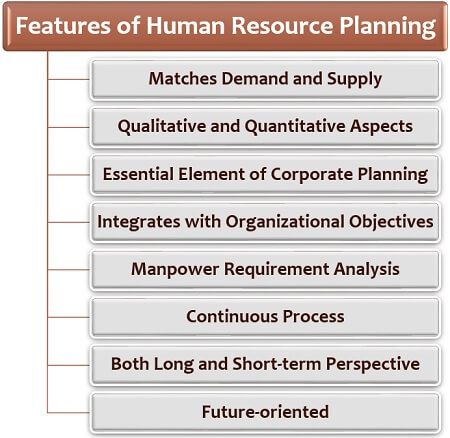
- Matches Demand and Supply: Human resource planning intends to meet the workforce demand of the organization through an adequate supply of competent workforce.
- Qualitative and Quantitative Aspects: This is a systematic approach where the company ensures the availability of personnel possessing the required skills, qualification, experience, etc. in the correct proportion.
- Essential Element of Corporate Planning: HRP can be seen as a vital component of the company’s overall business strategy, that deals explicitly with the manpower inventory.
- Integrates with Organizational Objectives: The ultimate purpose of HRP is to accomplish its part in the achievement of organizational goal.
- Manpower Requirement Analysis: HRP is all about determining the company’s workforce requirement and its availability.
- Continuous Process: Since, employee turnover, layoff, retirement, death, etc. are neverending activities, HRP becomes a constant practice in any organization.
- Both Long and Short-term Perspective: The company can aim at the fulfilment of its short-term as well as the long-term HR goals through proper manpower planning.
- Future-Oriented: HRP is primarily performed to analyze and meet the forthcoming personnel requirement in the organization.
Need for Human Resource Planning
The HRP is a much broader concept than recruitment. It became essential for companies to plan their human resource due to the following reasons: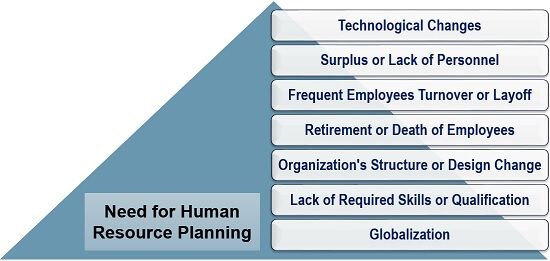
Technological Changes
When companies encounter technological upgradation, the demand for trained and expert personnel also arises.
Surplus or Lack of Personnel
HRP is essential to effectively evaluate the difference between the human resource requirement and personnel availability. Thus, it ensures that neither there is excessive nor scarce manpower in the organization.
Frequent Employees Turnover or Layoff
The company often faces the resignment or termination of employees due to one or the other reason. It leads to new vacant positions and human resource planning.
Retirement or Death of Employees
HRP ensures succession planning for the positions vacant due to an employee’s demise or cessation of the service tenure.
Organization’s Structure or Design Change
When the organization diversifies or expands its business operations, it also needs to magnify its human resource structure and composition.
Lack of Required Skills or Qualification
Sometimes, on analyzing the existing manpower quality, the company finds out that its personnel does not possess the desired skill set or qualification. Therefore, HRP is considered crucial.
Globalization
While expanding the business in different countries, the company prefers to appoint personnel residing in those particular countries. This develops the necessity for HRP.
Human Resource Planning Process
How is human resource planning incorporated in a real business situation?
For the answer to the above question, we need to go through the following steps involved in an HRP process: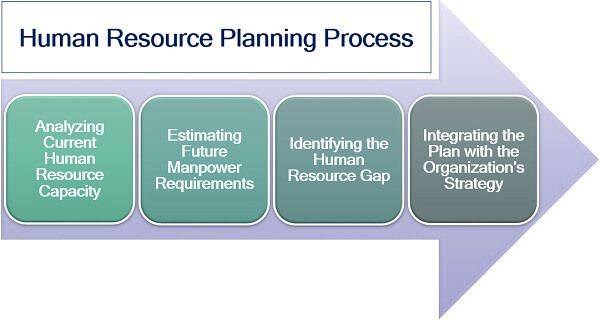
Analyzing Current Human Resource Capacity
The first step is to determine what we already have. Thus, the company initially identifies the strength, composition, title, skills, knowledge, experience, qualification, compensation and performance rating of the employees.
Estimating Future Manpower Requirements
Next, we need to forecast the future human resource scenario. For this purpose, the company needs to consider various aspects such as organizational strategy and prospective vacancies.
It also evaluates and times the employees’ retirement, layoff, attrition; along with other termination modes and promotion.
Identifying the Human Resource Gap
Using the information gathered in the above steps, the company can figure out if there is any difference between the manpower demand and supply.
The human resource manager should then plan a suitable strategy to fill in this gap and ensure effective human resource management in the organization.
Integrating the Plan with the Organization’s Strategy
The most significant step is to align this human resource approach with the organizational goals and strategy.
This human resource plan needs to be integrated with different managerial activities like budgeting, financing, personnel selection, training, retention, etc.
Human Resource Planning Importance
We have already gone through the reasons for which HRP is adopted in a company. Let us now find out its significance for the business organizations: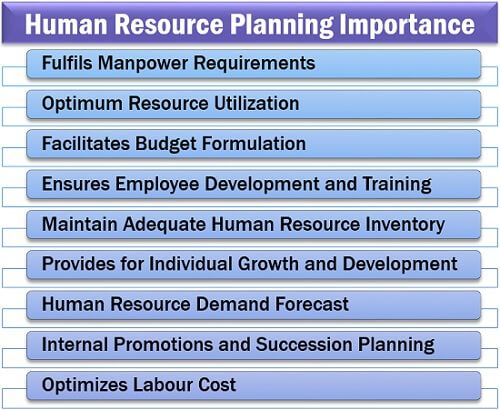
Fulfils Manpower Requirements: Human resource planning equips the company with an interminable supply of suitable manpower.
Optimum Resource Utilization: This practice also provides for constant analysis of the available human resource in the organization, ensuring their efficiency and effectiveness.
Facilitates Budget Formulation: HRP helps to frame the company’s human resource budget, which is essential while planning the overall budget of the organization.
Ensures Employee Development and Training: Examining the organization’s human resource often results in initiating the employees’ training and development programs to incorporate the desired skills.
Maintain Adequate Human Resource Inventory: With a proper human resource planning, the company can ascertain competent and efficient manpower availability in the organization.
Provides for Individual Growth and Development: HRP prioritizes the progress of the employees as individuals, too, through the benefits like learning programs, personality development, salary increments, promotions, etc.
Human Resource Demand Forecast: HRP enables the organization to anticipate future conditions like scarcity or shift of workforce, and prepare in advance for such events.
Internal Promotions and Succession Planning: It also evaluates the potential of existing human resource to accomplish internal recruitment activities like succession planning and internal promotion.
Optimizes Labour Cost: An adequately planned human resource strategy can ensure organizational savings on the labour cost such as salary, wages, commission, allowances, etc.
Human Resource Planning Problems
Human resource planning has been seen as an essential managerial activity. However, the company comes across various difficulties during its implementation. Some of these are as follows: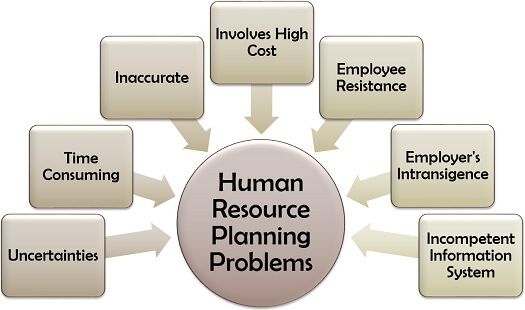
- Uncertainties: The planning of manpower is to various ambiguities like employee turnover, absenteeism, market variations, technological advancement, etc.
- Time Consuming: The human resource demand forecasting, planning and its implementation is a lengthy process.
- Inaccurate: HRP is not an error-free method since it is merely base on estimates and judgements.
- Involves High Cost: This a future-oriented process and therefore requires expenditure on research, information gathering, forecast and database management.
- Employee Resistance: The employees assume HRP as procurement of manpower from external sources and try to get rid of it, considering it as a burden.
- Employer’s Intransigence: The employers assume that the employees are readily available whenever needed, and the business does not need to invest any time and money in such a practice.
- Incompetent Information System: Sometimes, a human resource information system fails to provide sufficient or accurate information, hindering the HRP process.
Conclusion
Human resource planning is an intrinsic part of the company’s growth strategy.
An organization comprises of various unskilled, skilled and semi-skilled personnel who are directly or indirectly associated with the business success. Therefore, many companies have now started valuing their workforce as an asset to the business.
Leave a Reply